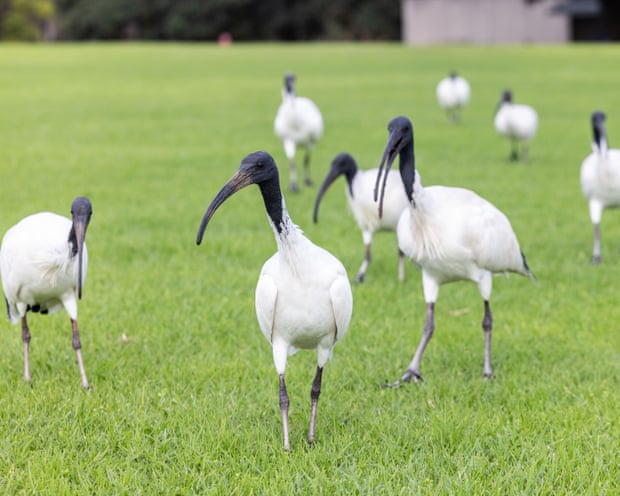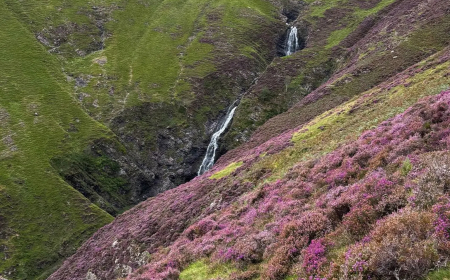Bin chickens galore! Why are there so many ibis in Sydney?
Rainy weather emboldens the scavenging species – climate refugees driven from their wetland homes

Rain slicks the pavement at Sydney’s Prince Alfred Park. Commuters hurry under umbrellas, takeaway bags clutched tight.
But one group remains unbothered – heads tilted, shoulders hunched, beaks long. It’s lunchtime, and the ibis are here to eat.
Some call these birds pests. They rule the streets of Sydney with a slow swagger. Hungry for scraps, they know exactly where to find them.
The scavengers use their long black beaks to riffle through rubbish bins near Central station, hissing at schoolkids; they loiter at bus stops and nest high in Hyde Park’s palm trees – their version of inner-city high-rise living.
Dr John Martin, an ibis expert and senior ecologist at Ecosure, says ibis numbers in Sydney are peaking but its unclear how many are wandering the city.
Populations boomed in the 1970s, early 2000s and again about 2010 but a lack of national monitoring means there’s no official headcount.
Once primarily floodplain dwellers, Australian white ibis – AKA Threskiornis moluccus or “bin chickens” – began moving to coastal cities in search of reliable food, water and shelter. Their shift to urban areas as inland habitats dry up is a climate-driven wildlife migration.
Sydney has proved to be fertile ground for the versatile ibis.
They flock to parklands in rainy weather, where worms that wriggle to the surface become a tasty snack.
Wet days can make it seem as though the birds are multiplying but Martin says the city’s ibis population peaks in spring and declines in autumn as chicks die off or birds migrate away from the greater Sydney region.
With pesky people indoors, ibis have free range to scavenge human scraps and natural food sources – and maybe even find love.
The ‘bin chicken’ effect
Despite the native birds being protected under Australian law, ibis continue to polarise public opinion. Their increased populations don’t pose ecological risks.While older residents remember a time before they became an Australian city staple, younger generations have grown up seeing them in memes and on children’s programs including Bluey, where they’re affectionately portrayed. Their “bin chicken” nickname has cemented their cult status.
Still, not everyone is a fan.
Ibis have been blamed for mess, noise and nuisance behaviour in schools and parks. Complaints to councils are common.
“It really is human-wildlife conflict,” Martin says.
Ibis control is authorised by the New South Wales government and councils can apply for permits if intervention is deemed necessary.
In 2003 the ABC reported that Bankstown council had hired a professional pest exterminator to shoot the birds after striking a deal with the National Parks and Wildlife Service.
But lethal control is now rare and strongly discouraged. “That’s certainly not the approach National Parks supports these days,” Martin says.
Early in his career Martin volunteered on ibis monitoring projects where nest and egg destruction were routine methods of control. His PhD examined whether such techniques had any real impact.
Today management efforts are more creative: redesigned bins that ibis can’t access, habitat modifications and public signs asking people not to feed birds.
“Palm trees are a great example,” Martin says. “I call it the pineapple effect – if you remove the sideways trunks, you remove nesting platforms.”
Call for coordinated action
Martin says the rise of urban ibis is a warning sign, as the birds represent many inland species that rely on healthy wetlands. “Ibis are waving the flag,” he says.
Memory of past droughts and water restrictions may have faded in cities but drought, damming, agriculture and water overuse have left wetlands struggling.
A spokesperson for the Canterbury-Bankstown council says a unified metropolitan-wide strategy is needed, including public education about bird feeding and better food waste disposal – all while recognising the bird’s native status.
“This is a Sydney-wide problem,” the spokesperson says.
Despite their ubiquity, ibis remain surprisingly understudied.
Martin encourages citizen scientists to log sightings through the Big City Birds platform.
For now, the ibis remains a fixture – and reminds us that nature doesn’t end at the edge of the suburbs.
[Source: The Guardian]




















/file/attachments/orphans/1000146612_845134.jpg)
































